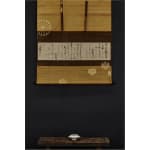Emperor Gomizuno’o (1596–1680)
Letter to Nakatsukasa-tono
Ink on paper, hanging scroll
With authentication by Kohitsu Ryomin and Kohitsu Ryochu
Important Art Object
17.6 x 72.7 cm
90.2 x 74.6 cm (overall)
With authentication by Kohitsu Ryomin and Kohitsu Ryochu
Important Art Object
17.6 x 72.7 cm
90.2 x 74.6 cm (overall)
Provenance
Collection of the Date clan (Sendai)
This letter by Emperor Gomizuno’o once belonged to the Date clan in Sendai Domain. It was sent to a certain “Nakatsukasa-tono” (literally, “Minister of Central Affairs”), whose identity is unclear. In it, the emperor responds to a request to name two aloeswood fragrances.
The letter states: “I am writing on the matter of the fragrance names. It has been difficult to refuse this request as I have been asked [to come up with names] a while ago now, so I would like to propose adopting the first idea. The scents of these two fragrances are very hard to differentiate, so how about likening their essence to an ancient poem and calling one “Spring Bank” and the other “Summer Bank”? I am sure you also have your own preference, so let us take that into account. I look forward to discussing this with you when you come here next.”
Fragrant woods were customarily given poetic names according to their aroma and form with reference to ancient poems, customs, or traditions. Emperor Gomizuno’o, being well versed in a variety of traditional art forms, contributed to naming many fragrances. The poem citied in the letter is by Prince Yasusuke’s mother from Senzai wakashu (Collection of a Thousand Years). Since the two fragrances were difficult to distinguish, the emperor suggested naming them “Spring Bank” and “Summer Bank” respectively, referencing the poem by Prince Yasusuke’s mother, in which one bank of the river was allocated to spring and the other to summer because the wisteria overhanging the river blossomed from spring through to summer, and it was impossible to say in which season it was more beautiful. This scroll is highly prized as a document by Emperor Gomizuno’o, who all excelled in the arts, and prominently stands out among Edo-period emperors, as well as for its distinguished provenance, giving it the designation of Important Art Object. The resplendent Imperial crests of the chrysanthemum and the paulownia on the mounting underline the nobility of its origins.
Emperor Gomizuno’o (1596−1680)
Also known as Masahito; Sannomiya; Gyokuro (haiku poet’s pseudonym).
The 108th Emperor of Japan. The third son of Emperor Goyozei. His mother, Konoe Sakiko, was the daughter of Konoe Sakihisa. Keen on poetry composition, including renga (linked poetry) and others. Mostly excelled at waka (Japanese-style poetry) writing, and composed hundreds of waka. His poetry works are collected in the anthology Oso-shu (Collection of the Seagull’s Rookery).
The letter states: “I am writing on the matter of the fragrance names. It has been difficult to refuse this request as I have been asked [to come up with names] a while ago now, so I would like to propose adopting the first idea. The scents of these two fragrances are very hard to differentiate, so how about likening their essence to an ancient poem and calling one “Spring Bank” and the other “Summer Bank”? I am sure you also have your own preference, so let us take that into account. I look forward to discussing this with you when you come here next.”
Fragrant woods were customarily given poetic names according to their aroma and form with reference to ancient poems, customs, or traditions. Emperor Gomizuno’o, being well versed in a variety of traditional art forms, contributed to naming many fragrances. The poem citied in the letter is by Prince Yasusuke’s mother from Senzai wakashu (Collection of a Thousand Years). Since the two fragrances were difficult to distinguish, the emperor suggested naming them “Spring Bank” and “Summer Bank” respectively, referencing the poem by Prince Yasusuke’s mother, in which one bank of the river was allocated to spring and the other to summer because the wisteria overhanging the river blossomed from spring through to summer, and it was impossible to say in which season it was more beautiful. This scroll is highly prized as a document by Emperor Gomizuno’o, who all excelled in the arts, and prominently stands out among Edo-period emperors, as well as for its distinguished provenance, giving it the designation of Important Art Object. The resplendent Imperial crests of the chrysanthemum and the paulownia on the mounting underline the nobility of its origins.
Emperor Gomizuno’o (1596−1680)
Also known as Masahito; Sannomiya; Gyokuro (haiku poet’s pseudonym).
The 108th Emperor of Japan. The third son of Emperor Goyozei. His mother, Konoe Sakiko, was the daughter of Konoe Sakihisa. Keen on poetry composition, including renga (linked poetry) and others. Mostly excelled at waka (Japanese-style poetry) writing, and composed hundreds of waka. His poetry works are collected in the anthology Oso-shu (Collection of the Seagull’s Rookery).



